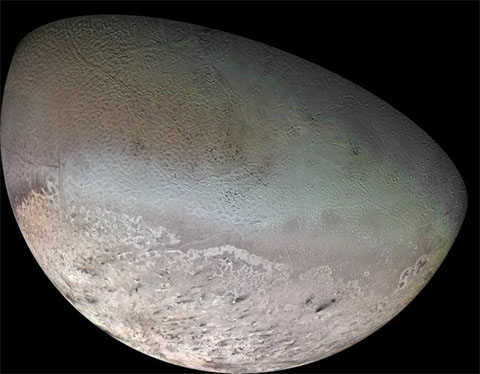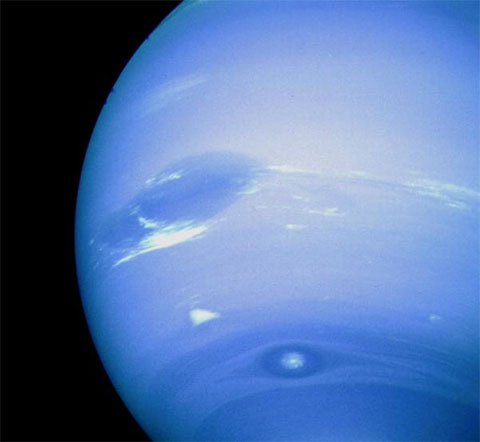

| Archive Blog Cast Forum RSS Books! Poll Results About Search Fan Art Podcast More Stuff Random |
|
Classic comic reruns every day
|
1 {photo of Neptune}
1 Caption: The Blue Planet
|
First (1) | Previous (3289) | Next (3291) || Latest Rerun (2888) |
Latest New (5380) First 5 | Previous 5 | Next 5 | Latest 5 Annotations theme: First | Previous | Next | Latest || First 5 | Previous 5 | Next 5 | Latest 5 This strip's permanent URL: http://www.irregularwebcomic.net/3290.html
Annotations off: turn on
Annotations on: turn off
|
 Ceres. Public domain image by NASA's Hubble Space Telescope. |
Spurred by the apparent success of Titius and Bode's mathematical "law" in providing the orbital distance of Uranus, astronomers were keen to find something in the missing orbit between Mars and Jupiter. A concerted effort involving dozens of astronomers organised by Johann Bode himself began in 1800, scouring the skies to search for the missing planet. An invitation to join the hunt was on its way to Giuseppe Piazzi of Sicily, when on the first day of 1801 he independently found what the group was looking for. It was a faint point of light moving nightly against the stars, and turned out to have an orbit between Mars and Jupiter, almost bang on the distance predicted by Bode. Piazzi proposed the new planet be named after the Roman god of agriculture, and so it became known as Ceres.
It was immediately clear that Ceres was very faint, and therefore very small compared to the other planets. What's more, other astronomers soon found other new planets at roughly the same orbital distance. By 1807, four of them had been found. William Herschel commented that they were so small as to appear almost indistinguishable from stars through a telescope, and called them collectively asteroids, meaning star-like. Nevertheless, Ceres and its three fellow asteroids Pallas, Juno, and Vesta, were listed as planets in most almanacs until around 1850. For this fifty year period, our solar system had eleven planets.
 Urbain Le Verrier. Public domain image from Wikimedia Commons. |
A way came along when people made detailed calculations of the orbit of Uranus. Between 1821 and 1846, at least three independent astronomers noticed that the observations of Uranus's position did not quite match the orbital predictions. Each one surmised that the planet was probably being influenced gravitationally by another planet, as yet unknown and so not taken into account in the calculations. By 1846, John Couch Adams and Urbain Le Verrier had made independent calculations of the likely position of the unfounded planet, based on the observations of Uranus. Neither had much luck convincing their observational friends to actually start looking, though. Undaunted, Le Verrier published his results.
Sir George Airy, the Astronomer Royal, had supplied Adams with some of the observational data used to make his calculations, so he was familiar with Adams's result, even if not convinced. But perusing the latest astronomy publications from the Continent, he found Le Verrier's publication. He immediately noticed that Le Verrier's predicted location for a new planet was very similar to Adams's. This convinced him to start searching. Airy asked James Challis of the Cambridge Observatory to spend some time looking around the predicted location of the planet. He searched for a couple of months but did not find anything.
However Le Verrier had by now also sent a letter to Johann Galle of the Berlin Observatory, asking him to look for his predicted new planet. Galle received the letter and showed it to his student Heinrich d'Arrest. d'Arrest suggested that they could use the observatory's star charts of the region of sky and look for anything not recorded on them. That very night they observed a patch of sky around Le Verrier's predicted position, compared it to the star chart, and found what they were looking for. An object, too faint for the naked eye but easily visible through the telescope, which should have been on the star chart if it was a fixed star, but was not. The date was 23 September, 1846.
 Views of Neptune seen by the Hubble Space Telescope. Colour is enhanced. Public domain image by Lawrence A. Sromovsky and NASA/ESA. |
Neptune is too distant and hence the sunlight it reflects is too faint to be seen by the naked human eye. But it is visible through even a modest telescope. After its discovery in 1846, it came to light that the planet had actually been recorded in star chart sketches by earlier astronomers, without them realising what it was. In particular, Galileo himself made two sketches which show Neptune precisely in its expected orbital position in late 1612 and early 1613, very close to the position of Jupiter (which is what he was interested in at the time). Galileo may be forgiven for not recognising what he saw, because Neptune at that time was located so that its movement across the sky was very slow relative to Earth's position, and also because the thought that there might be more planets than the six known since antiquity was largely unthinkable.
However, records from the Paris Observatory made in 1795, 14 years after Herschel's discovery of Uranus, show that Neptune was observed and recorded on the 8th and 10th of May in that year. The two observations do show a small motion of the planet across the sky, but this is noted in the records as a possible observation error in the position of the "star". So it was chalked down to a mistake, and never followed up. Despite these near misses, these observations proved extremely useful when they were uncovered shortly after Le Verrier and Galle's discovery, since they extended the time baseline of observations of the new planet from a few years to over 200 years, which allowed orbital calculations to be made much more precise almost immediately.
Neptune orbits the sun at an average distance of close to 30 AU (astronomical units; one astronomical unit being the orbital distance of Earth, about 150 million kilometres). Although its discovery was a triumph for the quantitative and predictive science of astronomy, it dealt a blow to the Titius-Bode law. Counting Ceres as a planet (which people at the time were still doing), the mathematical progression of orbits predicted by Titius-Bode were matched with an error no greater than about 5% (for the case of Mars). However it predicted that the next orbit beyond Uranus should be at 38.8 AU. The "error" in Neptune's orbit was almost 30%. Almost simultaneously, there had been a growing number of new asteroids being discovered in the gap between Mars and Jupiter. Ceres, Pallas, Juno, and Vesta did not have that space to themselves as four small planets. A fifth asteroid, Astraea, was found in 1845.[1]
 Triton imaged by Voyager 2. Dark smudges at bottom are dust trails behind geysers. Public domain image by NASA/JPL. |
Like Uranus, Neptune remained a mystery from its discovery right up to the late 1980s. Some moons were discovered - the largest, Triton, just 17 days after the planet itself had been identified in 1846. A second, much smaller, moon was not found for over 100 years, when Nereid was found in 1949. A third tiny moon, Larissa, was found only in 1981. About the only other thing known about Neptune was that it was similar in size and composition to Uranus: mostly methane, ammonia, and water ice, with a thick atmosphere of hydrogen, helium, and methane.
The first, and so far only, space probe to visit Neptune was Voyager 2, which arrived in the Neptune system in 1989, three years after its encounter with Uranus. Uranus had turned out to be, as far as the general public were concerned, a bit of a dud after the spectacular images returned of Jupiter and Saturn. Uranus in contrast had presented a bland, uniform planet, and the only thing of interest were its handful of cratered moons. Neptune, being even further from the sun, was expected to be similarly bland, without any appreciable weather or cloud formations to make it visually interesting. What Voyager found was a surprise.
 Neptune imaged by Voyager 2. Public domain image by NASA/JPL. |
Voyager also captured detailed photographs of the largest moon Triton. Triton is the seventh largest moon in our solar system, after Jupiter's four Galilean moons, Saturn's Titan, and our own Moon. It is almost twice the size of Uranus's two largest moons, Titania and Oberon. What's strange about Triton though, is that it orbits Neptune backwards, or retrograde, in the opposite direction to every other large body in the solar system. This implies quite strongly that Triton did not form with Neptune, but was a wandering body which got captured later by Neptune's gravity. In its position near the edge of the solar system, Neptune is near the Kuiper belt, where thousands of moon-sized bodies orbit at distances from 30 to 50 AU. This gives it prime opportunity to capture a large body, as it seems to have done. Furthermore, spectroscopic analysis of Triton and the Kuiper belt object Pluto show that they have very similar compositions, further strengthening the conclusion. Interestingly, Triton is larger than Pluto, and also larger than Eris (itself larger than Pluto). So if Triton had not been captured by Neptune, it may well have been the largest object in the solar system beyond Neptune.
Triton turned out to be interesting when Voyager photographed it too. It turned out to have icecaps, a thin atmosphere of nitrogen, clouds, and active cryovolcanism. Geysers of nitrogen gas spray dust into the atmosphere, and features on the surface show channels carved by liquid water or ammonia. The terrain of the moon is varied and fascinating, covered with dark spots where dust from geyser plumes has settled, channels, craters, and ridges. The moon resembles the texture of a giant rockmelon (a.k.a. cantaloupe).
 Clouds on Neptune. Public domain image by NASA/JPL. |
As it departed Neptune, giving us a tantalising taste of this eerie blue planet, Voyager 2 ended the primary mission of its grand tour of the outer solar system. Almost 36 years since launch, Voyager 2 still communicates with NASA scientists on Earth every day, reporting on magnetic and radiation conditions on the very edges of the solar system, where the sun's solar wind of emitted particles is stopped by the faint pressure of the interstellar medium. It is currently over 100 AU from Earth, over three times the distance to Neptune, and still going strong. (Voyager 1, which encountered only Jupiter and Saturn, is even further away, over 120 AU.)
At Neptune, we end the realm of the planets, but the solar system stretches beyond it for a vast distance. There are more bodies orbiting the sun that we have yet to discuss, or explore. We've probed the shores of the cosmic ocean, to quote Carl Sagan. We have a long way to go.
[1] It's cool that the fifth asteroid was named "Australia" in Strine. :-)
|
LEGO® is a registered trademark of the LEGO Group of companies,
which does not sponsor, authorise, or endorse this site. This material is presented in accordance with the LEGO® Fair Play Guidelines. |